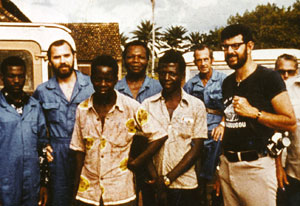Lessons learned from 1976 Ebola outbreak: Q and A with Fogarty Scientist Emeritus Dr Joel Breman
November / December 2014 | Volume 13, Issue 6

Photo courtesy of Dr. Joel Breman
Yambuku, 1976
Joel G. Breman, M.D., D.T.P.H., F.I.D.S.A., F.A.S.T.M.H., pictured on far right, was part of the international team that in 1976 identified and described the disease caused by a new, deadly virus in the Democratic Republic of the Congo: Ebola. Breman was with the CDC, where he spent much of his long career in global health, focusing on numerous infectious diseases that burden African populations. He has also worked for the WHO, certifying global eradication of smallpox and, more recently, guinea worm. He joined Fogarty in 1995 to direct institutional strengthening and research training programs. He retired in 2010, but continues to consult on topics such as malaria as Fogarty scientist emeritus.
What was it like to be on the ground for the first Ebola outbreak?
When our international investigation team of five arrived deep in the Zairian jungle at the epicenter of the first outbreak in 1976, we were scared out of our wits. We were working with the most basic protective equipment in the sweltering heat, sand flies were biting us, we developed rashes and didn't know if we would catch the virus too. But as I listened to witnesses describe what had happened, it was clear to me that the disease might have been spread by hospital procedures, which it had in part, through use of unsterilized injections. It also became clear that infection spread by close contact with infected body fluids.
How was it different from today's epidemic?
Many factors went into limiting the 1976 epidemic. Early on, a local doctor recognized it was a very different illness and within a few weeks, someone was out there taking a look. When our team arrived, the government had already cordoned off the area and quarantined 275,000 people - and they paid attention to the quarantine. The villages were isolated, both by the river and poor roads. But the current epidemic wasn't reported for several months and control efforts were meager; people fled into the forest and spread disease there or headed for the main roads that led them right to the cities and to neighboring countries.
On arriving in the villages back then, we worked hard to earn people's trust, showing community leaders an electron microscopic photo of the virus and saying we'd come to stop the disease spreading, treat patients and talk with their families. Our most important tool was house-by-house visits. And we reopened the hospital, which had been closed in response to staff deaths, to offer normal outpatient services and restore trust in the health system. In this epidemic, people were initially running away and not cooperating with the health care providers. The outbreak spread fast, moved to urban areas and belated attempts to contain it didn't work. In Liberia, for instance, quarantined people were short of food, unaware of how to protect themselves and increasingly distrustful. And there were not enough health workers to handle those who sought help.
What did you learn about Ebola in 1976?
We found it essential to have a group able to lead efforts overall, to organize and coordinate with others and form partnerships with community leaders. For instance, we delegated a scientist to do serology, a communications officer, a physician managing the clinical care and I was in charge of epidemiology and surveillance. For every step, it's important to ensure transparency and to communicate extensively about what's going on. Then you need infrastructure for the teams to carry out effective logistics, transport and identification of patients.
What role can scientists play?
In Zaire, we conducted surveillance and epidemiology. We collected information on the clinical spectrum, incubation period and transmission routes, and instituted control measures that seemed to work, such as quarantine and rapid burial of corpses. We did lab diagnosis and some virology in the field. It is essential to share the information that has been collected. In this outbreak, there is so little scientific information in regard to what we need to know, such as age of patients, sex, types of contact the patients had and mode of acquisition. We also want details on the clinical presentation and results of treatment.
Further research should include many different kinds of specialists. We never identified the animal source of the virus so we need ecologists and naturalists to do longitudinal studies on fruit bats, great apes and other species. We need social scientists and anthropologists to study how best to talk with local leaders, educators and villagers and to study socially acceptable but safe ways to conduct burials and have workable isolation and quarantine. And health systems everywhere in the region need to be strengthened. There will be new microbes that arise where you have animals in contact with humans. We have to be prepared to not only detect and respond to them but to prevent them from taking hold.
To view Adobe PDF files,
download current, free accessible plug-ins from Adobe's website.